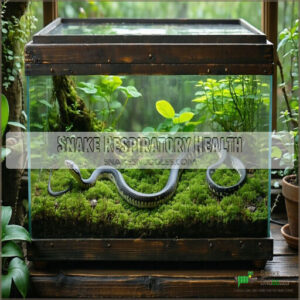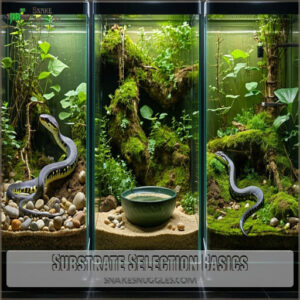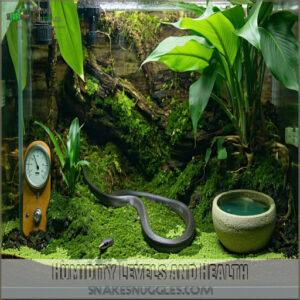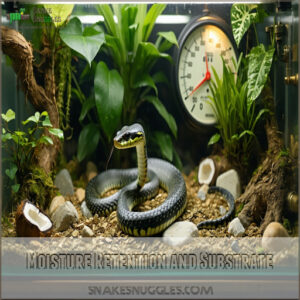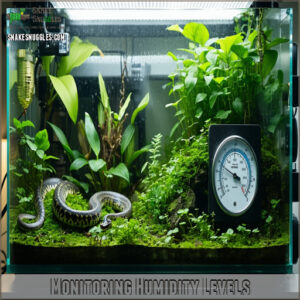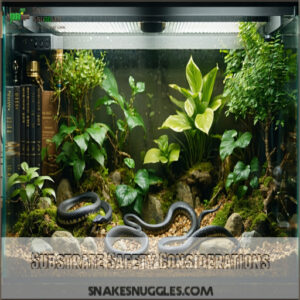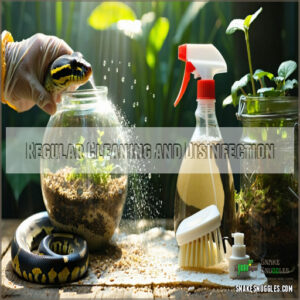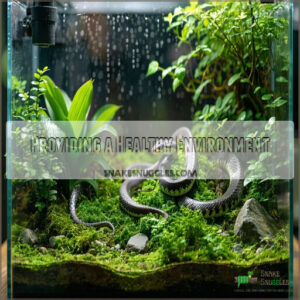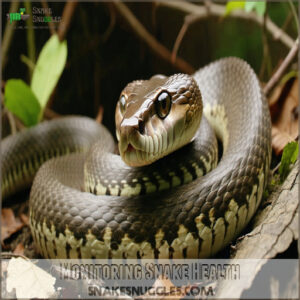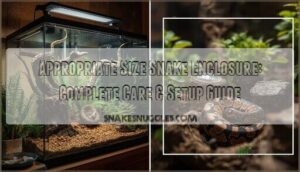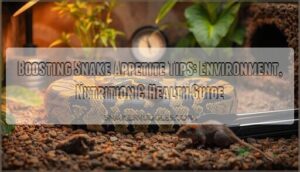This site is supported by our readers. We may earn a commission, at no cost to you, if you purchase through links.
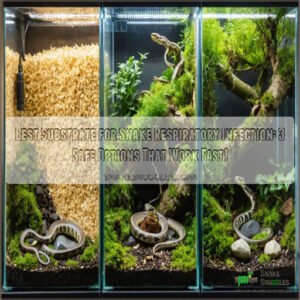
Choose a safe one like coconut fiber, cypress mulch, or sphagnum moss. Avoid cedar shavings and sand, which can cause issues.
Monitor humidity levels and mist the enclosure regularly. The right substrate can make a big difference in your snake’s health.
Now, let’s get into the details of how to create a healthy environment for your pet snake, and what other substrates you can consider to keep them breathing easy.
Table Of Contents
- Key Takeaways
- Snake Respiratory Health
- Substrate Selection Basics
- Top 3 Substrates for Snakes
- Humidity Control Considerations
- Substrate Safety Considerations
- Preventing Respiratory Infections
- Frequently Asked Questions (FAQs)
- What is a good substrate for a snake?
- What is a good substrate for a Python?
- Why do snakes need a substrate?
- What is the best substrate for a corn snake?
- What is a good substrate for a garter snake?
- How do you apply a substrate to a reptile tank?
- What can I give my snake for a respiratory infection?
- What is the best substrate for snakes?
- How do you treat a respiratory infection in reptiles?
- What humidity should a snake respiratory infection be?
- Conclusion
Key Takeaways
- You’ll want to choose a safe substrate like coconut fiber, cypress mulch, or aspen shavings to prevent respiratory infections in your snake, as they’re gentle on their skin and easy to clean.
- It’s crucial to monitor humidity levels and maintain proper moisture control, with ideal humidity ranging from 50-70%, to help your snake recover from a respiratory infection and prevent future issues.
- You should avoid substrates like cedar shavings, sand, and walnut shells, as they can cause respiratory problems and other health issues in snakes, and instead opt for natural, eco-friendly options.
- By selecting the right substrate and following proper maintenance, cleaning, and disinfection protocols, you’ll be able to create a healthy environment for your snake, reducing the risk of respiratory infections and keeping them breathing easy and healthy.
Snake Respiratory Health
You’ll keep your slithery friend breathing easy when you choose the right substrate that won’t irritate their sensitive lungs.
Just like you’d hate living in a dusty apartment, your snake needs clean bedding that maintains proper humidity and doesn’t kick up particles that could trigger respiratory issues, ensuring they have a healthy environment to thrive in is crucial, and providing the right conditions is key to preventing respiratory issues.
Importance of Humidity Control
Your snake’s respiratory health hangs in the balance of proper humidity control.
You’ll need to maintain perfect moisture levels to prevent dehydration or excessive dampness.
Monitoring humidity levels daily keeps your scaly friend’s air quality in check.
Remember, temperature regulation works hand in hand with hydration management—too dry, and your snake can’t shed; too humid, and respiratory infections lurk around the corner!
Role of Substrate in Respiratory Health
Your substrate choice can make or break your snake’s respiratory health. Think of it as their home’s foundation – it affects everything!
Poor substrates create a double whammy of problems: too much dust irritates sensitive airways, while improper Substrate Density impacts Humidity Control.
Respiratory Risks multiply when substrates trap moisture incorrectly. Your slithery friend’s Burrowing Needs must be balanced with Substrate Safety to keep those lungs happy.
Ensuring proper substrate moisture control is essential for maintaining a healthy environment, which is crucial for your snake’s overall well-being.
Common Respiratory Infections in Snakes
During snake care, you’ll want to watch for signs of respiratory infections.
These nasty bugs can be bacterial, viral, parasitic, or even fungal – and they’re often life-threatening.
Look for increased breathing rate, open-mouth breathing, or uneven swimming.
These breathing issues often start from poor air quality and living conditions.
Reptiles often suffer from various respiratory infections.
Remember, pathogens like mycobacteria and Salmonella can quickly turn a simple mouth infection into a full-blown respiratory crisis.
Substrate Selection Basics
You’re looking for the best substrate to help your snake recover from a respiratory infection, and it’s great that you’re taking this important step.
By choosing the right substrate, you can create a comfortable and healthy environment that supports your snake’s recovery and overall well-being.
Species and Humidity Needs
When choosing a substrate, consider your pet’s needs.
Some key points to remember:
- Humidity Control is essential
- Species Needs vary
- Burrowing Substrates are essential
- Moisture Levels matter
- Natural Environments are best
For humidity control, explore safe substrate options.
Safety and Avoiding Hazards
Think first about safety! Avoid toxic substances like cedar and pine shavings – they’re hazardous materials for snakes.
For snake safety, skip walnut shells (ouch!) and cat litter (yikes!).
| Hazard | Why It’s Bad |
|---|---|
| Cedar/Pine | Toxic fumes |
| Walnut Shells | Injury risk |
| Cat Litter | Abrasive, dusty |
If an emergency happens, like your snake eats something it shouldn’t, follow emergency protocols: contact a vet ASAP! Injury prevention is key – choose safe substrates.
Natural Behaviors and Habitat
When designing your pet’s space, consider their natural behaviors and habitat.
You’re creating burrow systems for them to thrive.
Incorporate natural substrates for environmental mimicry, boosting snake enrichment and overall well-being through habitat design.
Top 3 Substrates for Snakes
You’re looking for the best substrates to help your snake breathe easy and stay healthy.
Now, you’ll discover the top 3 substrates that are safe, effective, and work fast to prevent respiratory infections in your pet snake.
1. Kaytee Aspen Small Animal Bedding 52L
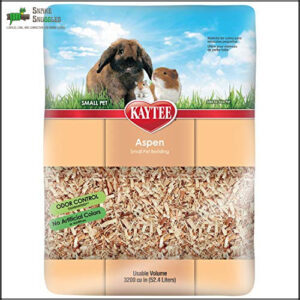
You’re looking for a safe substrate for your snake.
Kaytee Aspen Small Animal Bedding 52L is a great option, offering 99.9% dust-free comfort.
It’s made from natural aspen shavings, controls odor, and is easy to clean.
This substrate is perfect for snakes, promoting healthy respiratory function and a clean environment.
Give it a try for a happy, healthy pet.
Best For: small animal owners, including those with snakes, bunnies, guinea pigs, and chinchillas, who want a safe and healthy environment for their pets.
- Effective odor absorption and control, keeping the environment clean and fresh
- High absorbency, keeping cages dry and easy to clean
- All-natural and 99.9% dust-free, promoting healthy respiratory function
- Potentially higher price compared to other options
- Some reports of dust and clumping issues, despite being advertised as dust-free
- May not be as clumping as other brands, which can be a disadvantage for some users
2. Zoo Med Forest Floor Cypress Bedding
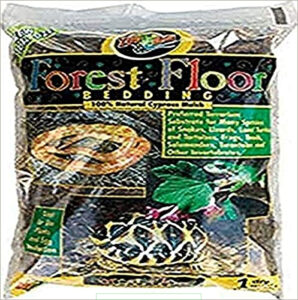
You’re considering Zoo Med Forest Floor Cypress Bedding for your snake.
This 100% natural cypress mulch is great for many species, maintaining moisture and allowing burrowing.
It’s a bit pricier, but a good option if you want a natural substrate that supports your snake’s behavior and health.
Best For: snake owners who want a natural substrate that supports their pet’s behavior and health, particularly those with species that require moisture and burrowing capabilities.
- May dry out quicker than other substrates
- Pricier option compared to other substrates on the market
- Requires regular cleaning and maintenance to prevent bacterial growth and other health issues
- Maintains moisture and enables natural burrowing behaviour
- 100% natural cypress mulch is a safe and healthy option for many snake species
- Supports a natural environment and allows snakes to exhibit natural behaviors
3. Flukers Loose Coconut Fiber Reptile Bedding
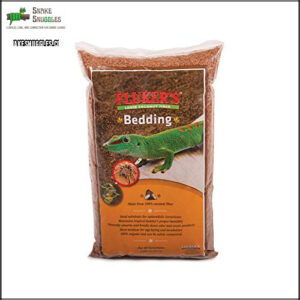
You’re checking out Flukers Loose Coconut Fiber Reptile Bedding.
This substrate maintains humidity, absorbs moisture, and is great for tropical reptiles. It’s also suitable for egg laying and incubation.
For more options, explore best snake tank substrates.
The coconut fiber is a natural, eco-friendly option that supports your snake’s health and well-being, making it a solid choice for their habitat.
Best For: reptile owners, especially those with tropical reptiles, who need a natural and eco-friendly substrate that maintains humidity and supports their pets’ health and well-being.
- Maintains humidity for tropical reptiles
- Absorbs moisture, minimizing decay and keeping the environment clean
- Suitable for various reptiles and invertebrates, including snakes, and ideal for egg laying and incubation
- Reported dryness and dustiness in some reviews
- Reported moisture retention issues in some reviews
- Packaging concerns and misrepresentation of bag weight have been reported by some customers
Humidity Control Considerations
You’re probably wondering how to keep your snake’s enclosure at the right humidity level, and it’s a great question.
By controlling humidity, you can help prevent respiratory infections in your snake, so let’s take a look at what you need to know.
Humidity Levels and Health
You’re choosing a substrate, now think about humidity control.
Proper humidity levels are key for snake health, impacting respiratory care and overall air quality, so manage moisture to keep your pet safe and healthy.
Moisture Retention and Substrate
You’ll want a substrate that retains moisture for humidity control.
Coconut fiber and cypress mulch are great options, meeting burrowing needs while keeping your snake’s home comfy.
They help maintain humidity, control odors, and create a natural environment, perfect for your pet’s health and happiness, with humidity control being essential.
Monitoring Humidity Levels
You’re managing moisture retention, now monitor humidity levels with a hygrometer.
Consider using a snake humidity monitor for accurate measurements.
Here are key steps:
- Check daily
- Calibrate often
- Avoid temperature fluctuations
- Maintain good air quality for your snake’s health, which is crucial for managing moisture retention.
Substrate Safety Considerations
You’re taking the right steps to keep your snake healthy by considering substrate safety.
Now, you’ll learn how to prevent Salmonella, mite infestations, and respiratory irritation, and create a natural-looking vivarium that’s perfect for your pet.
Salmonella Prevention
Salmonella prevention is key to your snake’s health and your own.
This bacteria can cause serious issues, so it’s essential to practice good hygiene.
Choosing a safe substrate is essential for preventing respiratory infections and other health problems.
Be sure to always wash your hands after handling your snake or cleaning their tank.
This simple act of hand washing is an effective way to stop the spread of Salmonella.
| Hygiene Practice | Disease Prevention |
|---|---|
| Hand Washing | Stops Salmonella Spread |
| Tank Sanitizing | Controls Bacteria |
Mite Infestations
You’ve protected your snake from Salmonella, now watch for mite infestations.
Check for Infestation Signs like tiny dots or uneven scales.
Use Cleaning Methods and Mite Prevention techniques, and do regular Snake Inspection for Mite Control to keep your pet safe and healthy.
Respiratory Irritation
You’re dealing with mite infestations, now let’s tackle respiratory irritation.
Dust control is key to maintaining good air quality and humidity levels, which directly impact your snake’s respiratory health.
So choose a substrate with low dust content to prevent respiratory irritation and maintain good air quality, which is crucial for your snake’s overall health, by controlling dust.
Natural-Looking Vivarium
Creating a natural-looking vivarium for your snake is like crafting a tiny, healthy ecosystem.
Think of yourself as a set designer, using these elements:
- Vivarium Design: Imagine a jungle or desert scene with hiding spots and climbing options.
- Natural Lighting: Mimic sunlight with UVB/UVA bulbs for a natural daylight cycle.
- Decor Options: Use branches, rocks, and hides that match your snake’s natural habitat.
- Plant Selection: Go for live plants to add a natural touch and extra humidity.
Preventing Respiratory Infections
You’re taking the right steps to keep your snake healthy by learning about preventing respiratory infections.
By choosing the right substrate and following proper maintenance, you can help prevent these infections and keep your pet snake happy and thriving.
You can help prevent these infections by following the mentioned steps, which will lead to a happy and healthy pet snake.
Proper Substrate Maintenance
You’re taking steps to prevent respiratory infections.
Proper substrate maintenance is key.
| Substrate | Replacement | Cleaning |
|---|---|---|
| Aspen | 4-6 weeks | Daily |
| Cypress | 4-6 weeks | Daily |
| Coconut | 4-6 weeks | Daily |
Monitor humidity, waste, and tank sanitizing.
Regular Cleaning and Disinfection
You’re doing great with proper substrate maintenance. Now, focus on regular cleaning and disinfection.
Daily spot cleaning and tank disinfection are key. Replace substrate regularly, following a cleaning schedule.
Choose gentle disinfectant options to keep your snake’s home clean and safe, preventing respiratory infections.
Effective reptile substrate cleaner methods are essential for maintaining a healthy environment, utilizing reptile care products to prevent the spread of disease.
Providing a Healthy Environment
You’re on the right track with regular cleaning.
Now, focus on providing a healthy environment with proper Environment Control, considering Snake Wellness and Habitat Design.
Finding appropriate snake bedding options is paramount for maintaining a healthy habitat, including Air Quality and suitable Substrate Depth to keep your snake thriving.
Monitoring Snake Health
You’re providing a healthy environment, now monitor your snake’s health with regular checks, focusing on Snake Nutrition and overall well-being.
Don’t hesitate to seek Veterinary Care if you notice any issues, it’s key to Disease Prevention and a happy, healthy pet.
Frequently Asked Questions (FAQs)
What is a good substrate for a snake?
You’re in luck, a good substrate for your snake is coconut fiber or aspen shavings, they’re safe, easy to clean, and comfy for your slithery friend.
What is a good substrate for a Python?
You’ll want a substrate like coconut fiber or aspen shavings for your Python, they’re gentle on their skin and easy to clean, perfect for a happy, healthy snake.
Why do snakes need a substrate?
You need a substrate for your snake to mimic its natural habitat, providing comfort and supporting its behavioral needs, like burrowing or climbing, to keep it healthy and happy.
What is the best substrate for a corn snake?
You’ll want a substrate like aspen shavings or coconut fiber for your corn snake, they’re gentle and easy to clean, perfect for a happy, healthy pet.
What is a good substrate for a garter snake?
You’ll want a substrate like aspen shavings or coconut fiber for your garter snake, they’re great for burrowing and gentle on their skin.
How do you apply a substrate to a reptile tank?
You’ll add substrate to your reptile tank by spreading it evenly, about 1-2 inches deep, and making sure it’s clean and dry before introducing your snake.
What can I give my snake for a respiratory infection?
Sadly, 75% of snakes get respiratory infections. You can give your snake a vet-prescribed antibiotic, and make sure a clean, humid environment to help them recover from the infection quickly.
What is the best substrate for snakes?
You’ll find coconut fiber, cypress mulch, and aspen shavings are great substrate options for snakes, offering a safe and healthy environment.
How do you treat a respiratory infection in reptiles?
You’ll want to consult a vet, who’ll likely prescribe antibiotics and recommend a clean, dry environment to help your reptile recover from the respiratory infection.
What humidity should a snake respiratory infection be?
You’ll likely need 50-70% humidity to help your snake recover from a respiratory infection, so keep that in mind when adjusting their environment.
Conclusion
You’ve learned about the best substrate for snake respiratory infection.
Did you know 75% of snake owners face respiratory issues?
Choose the right substrate, like coconut fiber, to prevent this.
By picking the best substrate for snake respiratory infection, you’ll keep your pet breathing easy and healthy.
- https://www.petmd.com/reptile/conditions/respiratory/respiratory-infections-reptiles
- https://www.reptiles.swelluk.com/help-guides/how-long-can-a-snake-live-with-a-respiratory-tract-infection/
- https://pubmed.ncbi.nlm.nih.gov/33892890/
- https://wpvet.com/reptile-rounds/respiratory-infections/
- https://azeah.com/reptiles-amphibians/respiratory-infections-reptiles

